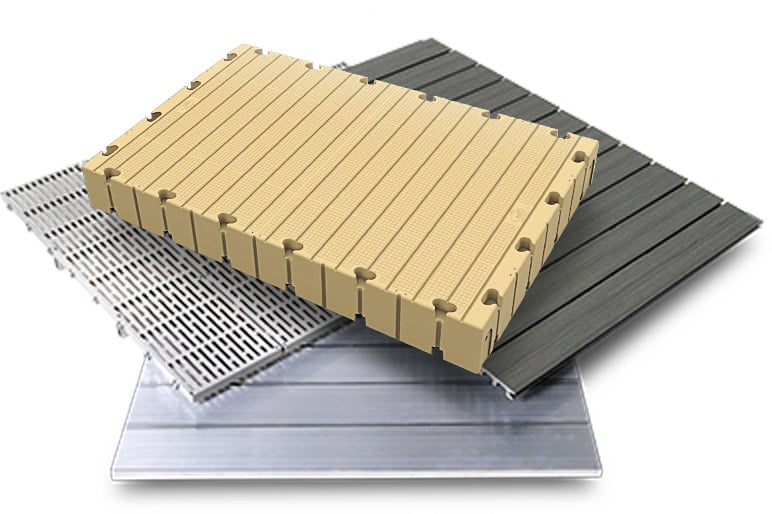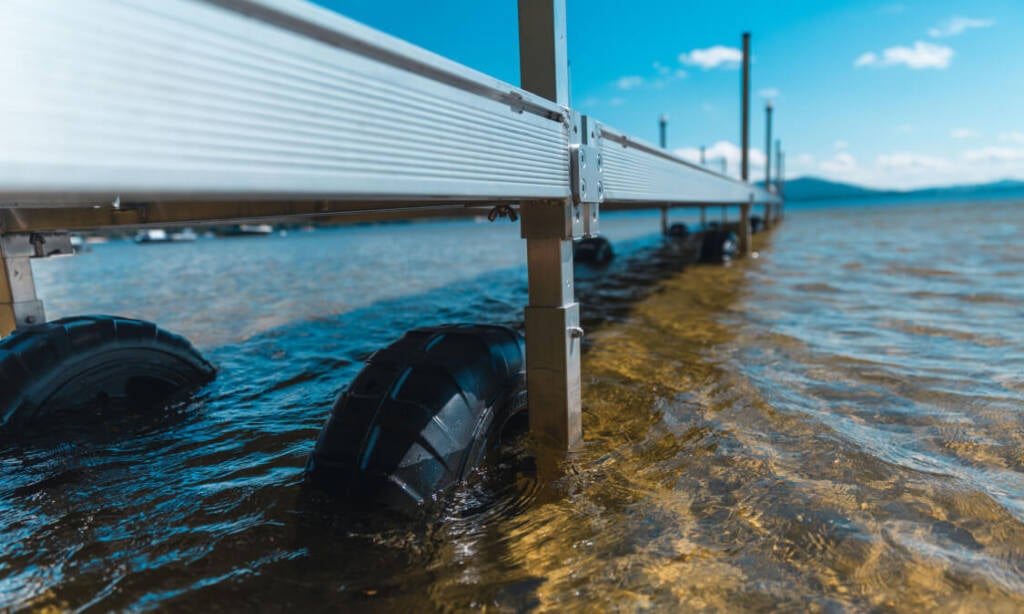Dock Design Ideas for Lakes, Rivers, and More
If you own a waterfront property, then a dock is an essential addition. Docks are versatile in use, providing easy access to the water for recreational activities such as swimming or fishing, allowing for transportation or even providing new commercial opportunities.
Just like any other addition to your property, you’ll need to put careful thought into a good dock design. While a simple dock will provide you with water access, a well-designed dock will offer the greatest usability, provide years of enjoyment and even increase your overall property value. That’s because a boat dock is considered one of the top 10 most valuable home improvements for a coastal property and can also add potentially thousands of dollars to the value of your home.
Here’s what you should consider for designing a new dock, plus some visual dock designs to help inspire you.
What Will You Use Your Dock For?
Start by determining how you will use your dock. This will help guide your dock design decisions on decking options, materials, layout, and accessories. You’ll need to determine if you’ll be using the dock for private recreation or for commercial purposes.
Start by considering whether your primary use for the dock will be to provide access to a boat or other personal watercraft or if you want to create an on-the-water living or recreational space. A straightforward dock is perfect for basic boat access, but a larger one with space for seating might be preferable if you plan to entertain or relax.
Residential Users who own a lake or river-front property as a primary or secondary residence — Your dock will primarily be used by friends and family, so you need a design and accessories that maximize comfort for a smaller group of people. Keep in mind the walkway width; if the dock leads to a larger living space, then you will want to increase the walkway width to accommodate easy movement for you and your guests, especially when carrying coolers or other items.
- Recreational Boaters — If you own a mid-sized boat or larger, then you’ll need enough space to dock the craft alongside. If you use smaller watercraft such as kayaks or jet skis, then you could consider adding launches for easier storage and access.
- Fishing Enthusiasts — If you like to fish, then casting off a dock is one of the best ways to land a prize catch. Docks not only provide you with greater access to deeper water, they serve as cover for smaller fish that can attract larger predator fish.
- Casual Users — You don’t need to own a boat or fishing equipment to enjoy a waterfront. Ladders and swim platforms support summer-time play in the water, while creating a larger “patio area” with chairs and tables parallel or perpendicular to the main dock can create a serene “living space” for relaxation.
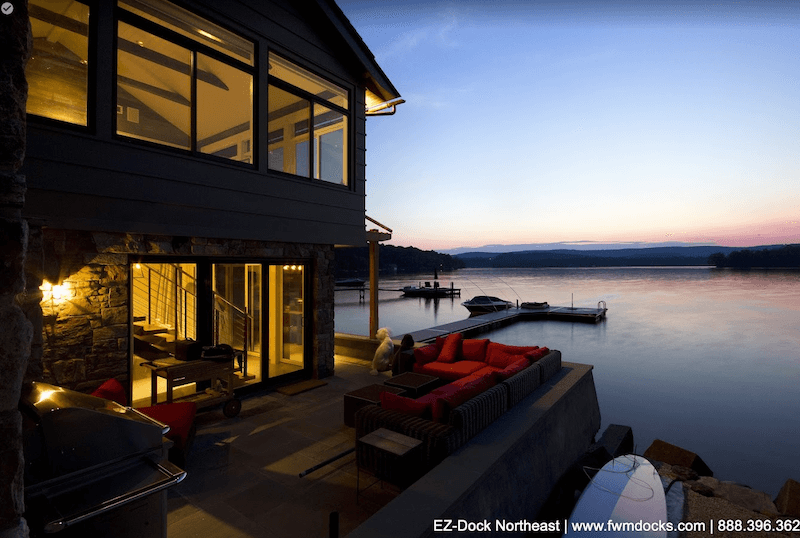
Commercial Users who own a business that operates on the water or waterfront property that’s open to the public — Your dock will primarily support your business operations, so you’ll need a functional and durable design that supports heavy use and maximizes accessibility.
- Camps and Recreational Grounds — Docks can provide many different activities for visitors, whether it’s providing multiple launches for watercraft, swim platforms for campers, or walkways that provide access to remote areas and islands. You should consider larger designs with a range of accessories.
- Industrial or Commercial Needs — If your business operates on a waterway, then consider a dock design that maximizes efficiency and access for loading and unloading. If you own a marina then you’ll want to consider a layout that allows users the best possible access to the water while also allowing for opportunities to expand in the future.
- Special Events — Docks are a great addition to waterfront hotels, clubs, or other properties to hold special events such as weddings, athletic competitions, concerts, and more. Both permanent dock systems and mobile, temporary docks are viable options.
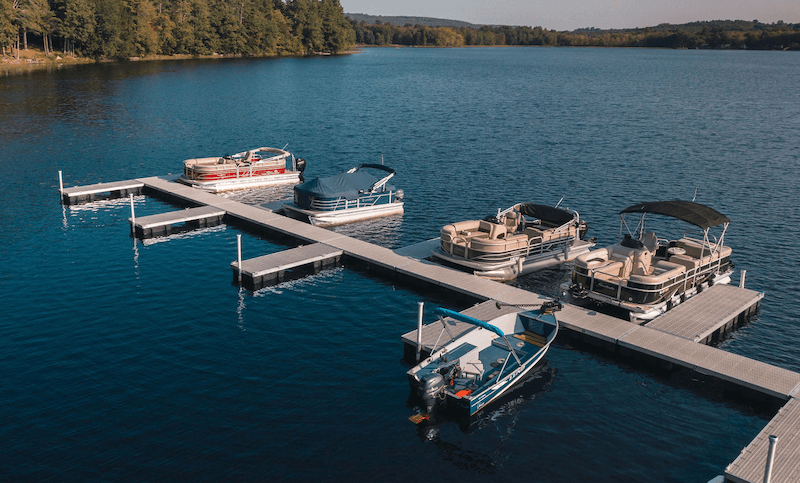
Considerations for Your Dock Design
Once you’ve determined the main uses for your dock, you’ll have to take stock of your waterfront conditions to narrow down your dock design ideas. Different designs, materials, and layouts will work better in different conditions.
- Dock Size — How large is the available area for your dock? Where are your property limits? Are you constrained by local regulations? Will you be docking boats? If so, what’s the largest size you can expect to accommodate?
- Water Conditions — Is the area freshwater or saltwater? Lakes and ponds are less corrosive than saltwater areas and don’t have currents like rivers do. In addition to strong currents, rivers may also be more subject to flooding. Areas with access to the ocean may experience more severe storm conditions and rougher waters.
- Water Level — How deep is the area near your shoreline? How much does the water level change, is it tidal or subject to possible flooding? Very deep areas will make it difficult, if not impossible, to install a stationary or rolling dock.
- Bed Condition — What’s the ground like under the water, is it mucky? Soft and sandy? Rocky? Sand, silt, and mud aren’t suitable for fixed docks, while rocky areas will prevent the use of rolling or stationary docks. Is there a risk of disturbing a vulnerable ecosystem? If so, you may need to choose a floating dock design.
- Shoreline — Different shorelines necessitate specific dock designs and anchoring methods. Is your access from a sandy shoreline with a gradual slope? Is it a rocky area with limited access? Do you have to pass over a coastal or inland wetland?
- Climate — The weather, especially winter conditions, can determine your material choices and maintenance requirements. Does the waterfront usually freeze over in winter? Floating docks will have to be removed from the water to protect them from icy buildup.
Decking Options and Materials
Once you know what your limitations and design requirements are, you can start considering your dock options. You will need to consider your options for materials, design, and layout.
Dock Material Considerations
- Durability — Which materials last longer and are more resistant to corrosion? Which materials are resistant to rough waters and strong currents?
- Maintenance —Will the dock be outside year round? How much time, money, and effort are you able to dedicate to your dock maintenance? How can you ensure the longevity of your dock?
- Cost — What is your overall budget? Which materials are more expensive and which designs will cost you more?
- Aesthetics — What’s the look that you want to achieve with your dock? Are there certain colors or materials that will best complement your property?
Review the following comparison table to see how different dock materials compare against each other.
Dock Materials Comparison
| Aluminum | Plastic | Wood | Composite Decking | |
| Applications | Residential, Industrial, Light Commercial | Residential, Industrial, Light Commercial | Residential, Marina | Residential, Marina, Public access |
| Water conditions | Fresh & saltwater (aluminum will oxidize over time in saltwater) | Fresh & saltwater | Fresh & saltwater | Fresh & saltwater |
| Benefits | Lightweight, Durable, Comfortable, Maintenance- Free | Lightweight, Durable, Comfortable, Maintenance- Free | Durable (if treated) | Durable, Comfortable |
| Drawbacks | May oxidize in saltwater | Heavy, Environmental impact, Splinters | ||
| Average cost | $$ | $$ | $ | $$ |
| Upkeep | Minimal buffing & scrubbing w/ soap & water | Scrubbing w/ soap & water | Sanding, Sealing, Replacing rotted boards | Scrubbing w/ soap & water |
| Durability (out of 10) | 9/10 | 9/10 | 6/10 | 8/10 |
| Environmental impact | Stationary docks may disrupt sediment | Recyclable, Not 100% ice-resistant | Pressure-treated wood can contaminate waterways, Stationary docks may disrupt sediment | |
| Safety hazards | Can overheat in direct sun w/out decking ventilation | Splinters |
For a further breakdown of dock materials — including steel and concrete — and which docks work best for specific conditions, see our blog post: Types of Docks Explained: Which Is Right for You?
Dock Design Considerations
- Installation — Does the shoreline and waterbed make it impossible to use certain designs? How much extra effort is needed to install a stationary dock?
- Usability — Will you remove the dock in the off-season? If so, will you do it yourself? Is there a need for future customization or expansion?
- Stability — Do you need a dock that is stationary and immobile, or something that changes with the water levels and has movement?
Compare and contrast the following styles of dock to see which best suits your needs.
Stationary docks are:
- The most stable of dock options due to being secured to the ground by pilings
- Unable to rise or fall with water levels
- Suitable for shallow or consistent water levels
- Sturdy to walk on and capable of withstanding strong currents
- Not the best fit for deep water or shores with constantly changing water levels
- Unable to accommodate rocky, silty, or muddy bed conditions; can disturb vulnerable ecosystems and environments
- Generally the most expensive to install
Rolling docks are:
- Often made of lightweight aluminum and feature a set of plastic wheels for easy setup and removal
- Easier to install than stationary docks, offering the ability for seasonal installation and removal
- Not usable in deep water and aren’t compatible with all shoreline conditions, particularly rocky or soft ground
- Very stable, but do not rise with changing water levels
Floating docks are:
- Able to float on the water using, foam billets, barrels, or air chambers
- More flexible to changing water levels due to not being tied to the ground
- More suited to deep water, since there’s no need to anchor the dock
- Easier and less expensive to install than stationary docks
- Less disruptive to sediment compared to stationary or rolling docks
- Able to be anchored for greater stability, but will still have some movement with the water
Dock Layout Considerations
- Required Layout — What is the number and types of watercraft you plan to dock? Are there any additional features like patio space or fishing areas that you’d like to include on your dock?
Layouts with more dock area allow for more activities and to dock a larger number of watercraft. However, larger configurations require more space and will cost you more for the materials. These common dock configurations should help give you some dock design ideas.
Common Deck Configurations

| I-shaped | L-shaped | T-shaped | F-shaped | U-shaped |
Lighting and Accessories
The right accessories will turn your dock from a simple platform into a true waterfront extension of your property. Specific add-ons can help protect your watercraft and make your launches and docking much easier. Lighting makes it possible to use your docks in the evening and at night and makes it more visible to other boats.
Consider these accessories and add-ons when coming up with ideas for your lake, river or oceanside dock:
- PWC Ports — Personal watercraft (PWC) lifts make docking and launching easy for almost any user. Lifts allow even beginners to safely dock and confidently store a Jet Ski, Sea-Doo, or other PWC.
- Kayak and Canoe Launches — Kayak launches make it easier than ever to board, exit, and launch your kayak or canoe.
- Boat Bumpers and Lifts — Boat bumpers protect both your boat and your dock from impacts. For smaller craft, boat lifts also provide a safe storage option in inclement weather.
- Swim platforms — Swim platforms give everyone quick access to the water and can even be customized with ladders, slides, or slips for kayaks or other PWC.
- Safety features — Safety accessories such as modular safety railings help protect your guests and loved ones. Gangways, ramps, stairs, and ladders improve accessibility to watercraft and the water.
- Lighting — Lights allow for nighttime use and ensure other boaters will see your dock at night. Lighting options include accent lights, solar lights, underwater lights, even colored lights to direct traffic.
- Accessories — There’s a host of accessories designed to make docking easier, such as tie-up cleats and mooring whips, as well as add-ons to support any leisure activity, including fish cleaning stations and bench seating.
Interested in more dock accessory ideas? See our blog post on the 7 Dock Accessories That Will Make Life More Comfortable.
Visual Inspiration for Your Dock Design
You’ve decided on what you’re going to use your dock for; narrowed down your materials, design, and layout; and even chosen a few accessory options. So what can you expect your new dock to look like?
We’ve chosen a few samples from real FWM Dock customers to show you what’s possible with your dock design. We hope the following pictures spark your imagination for your dock ideas.

A short stationary dock extends from a residential backyard into the lake, offering the homeowner quick and easy access to their watercraft and a swimming ladder.
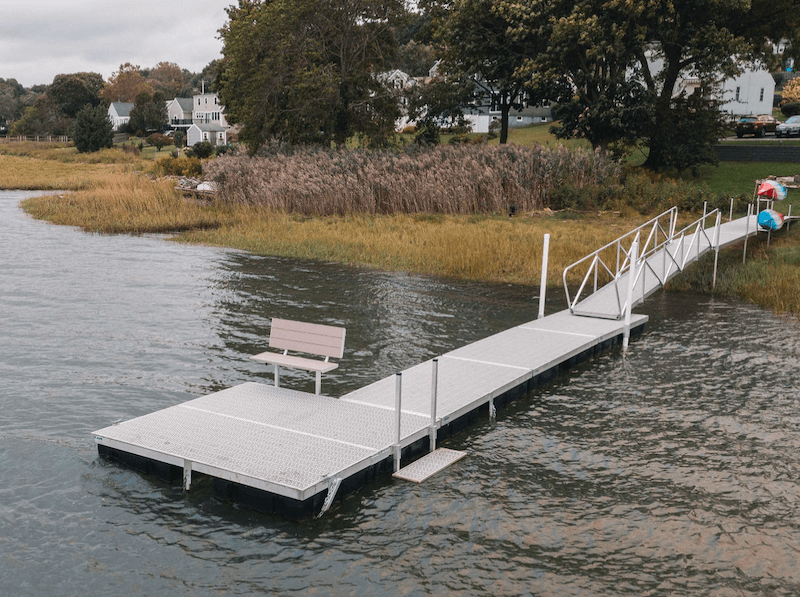
A floating dock provides a great spot for swimming and sitting, while attached racks provide a place to safely store kayaks.
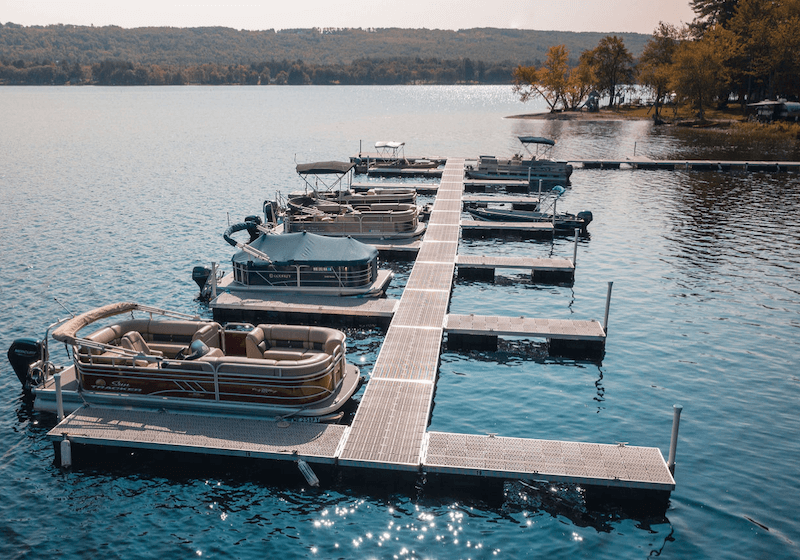
Floating docks can be used to create a small and convenient lake marina, allowing different boaters to safely and securely dock their vessels.
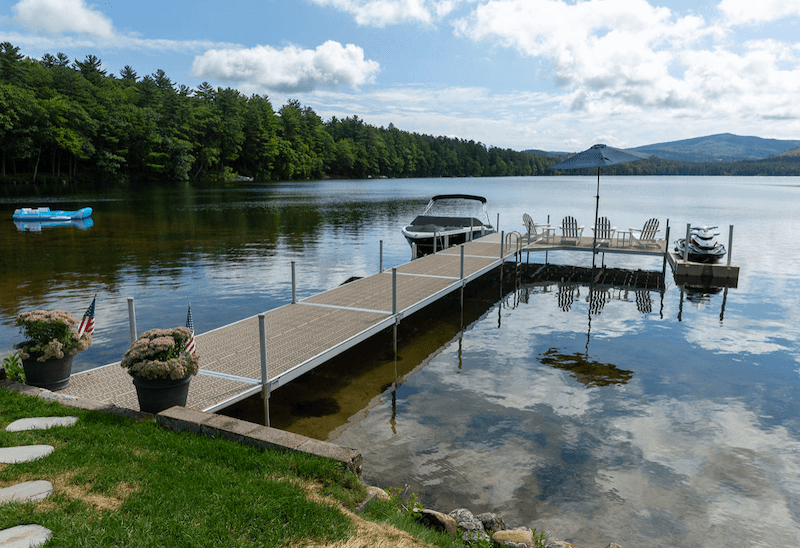
A combination of PWC craft lift, boat docking accessories, and outdoor seating on this stationary dock creates a host of waterfront activities.

A short stationary dock provides both a beautiful spot to rest and quick and easy swimming access.
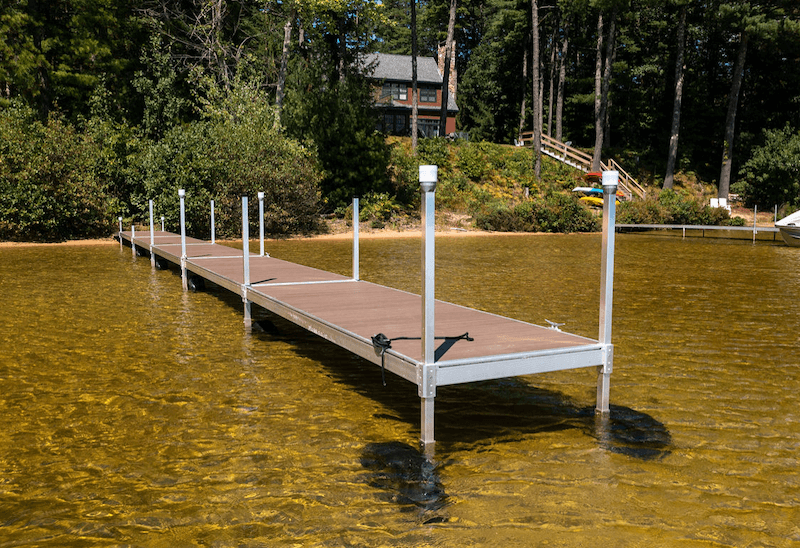
Sometimes simple is best, as this I-shaped rolling dock offers more access to this shallow lake for swimming, canoeing, and other activities.

Combining a dock with a swimming platform gives your guests and family members even more to do on the lake.
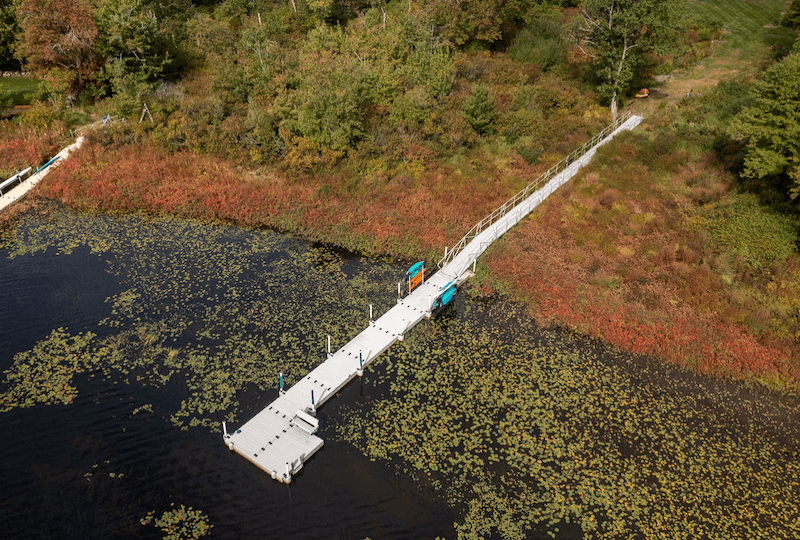
Docks can provide water access even without a sandy shoreline. Floating docks allow users easier access to swimming and kayaking as well as a spot on the water to sit and relax.
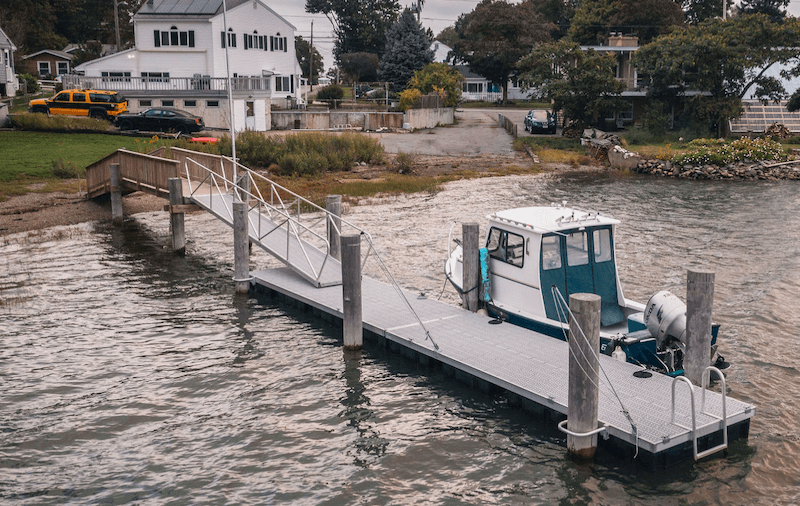
Floating docks can even be attached to existing structures for greater stability. This design provides a place to dock a small fishing boat without needing to install a new stationary structure.
While cost and budgeting will be a substantial factor in picking out your dock, you should take the time to consider what materials, design, and layout works best for the type of waterfront you live on. You’ll also need to consider how long you plan to use the property, if you want to expand in the future, and what your area and local government permits.
To assist you with your dock design ideas, download our free eBook for a guide on the 12 Questions to Ask Before You Buy a Dock.
